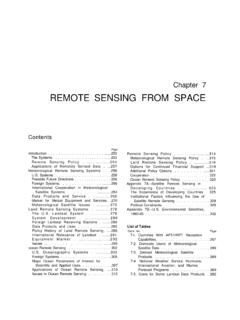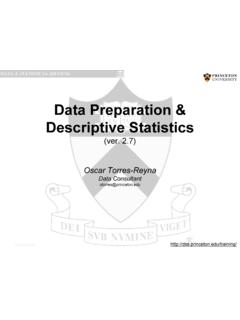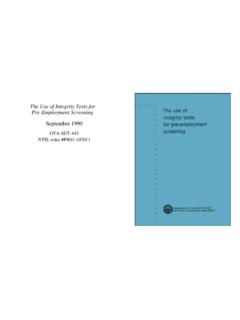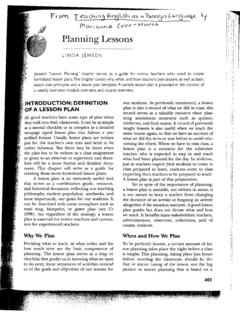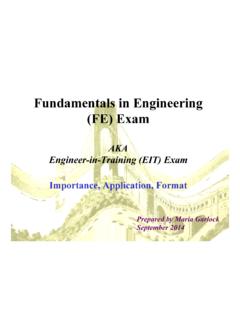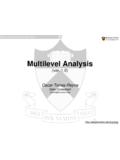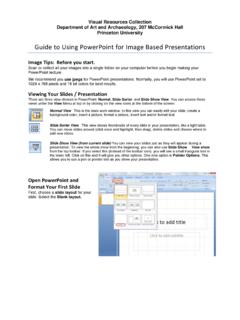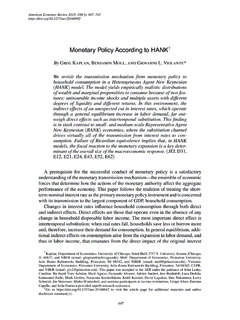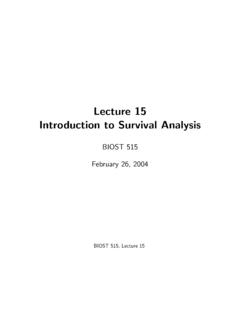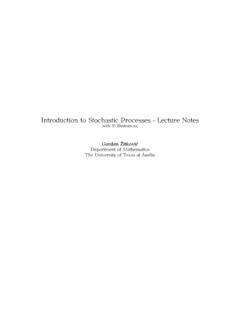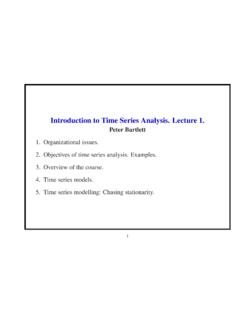Transcription of Lecture 7 Introduction to Fourier Transforms
1 Lecture 7 ELE 301: Signals and SystemsProf. Paul CuffPrinceton UniversityFall 2011-12 Cuff ( Lecture 7)ELE 301: Signals and SystemsFall 2011-121 / 22 Introduction to Fourier TransformsFourier transform as a limit of the Fourier seriesInverse Fourier transform: The Fourier integral theoremExample: the rect and sinc functionsCosine and Sine TransformsSymmetry propertiesPeriodic signals and functionsCuff ( Lecture 7)ELE 301: Signals and SystemsFall 2011-122 / 22 Fourier SeriesSupposex(t) is not periodic. We can compute the Fourier series as ifxwas periodic with periodTby using the values ofx(t) on the intervalt [ T/2,T/2).ak=1T T/2 T/2x(t)e j2 kf0tdt,xT(t) = k= akej2 kf0t,wheref0= 1 two signalsxandxTwill match on the interval [ T/2,T/2) but x(t) will be happens if we letTincrease?]]
2 Cuff ( Lecture 7)ELE 301: Signals and SystemsFall 2011-123 / 22 Rect ExampleFor example, assumex(t) =rect(t), and that we are computing theFourier series over an intervalT,T 1/21/2tf(t)=rect(t)The fundamental period for the Fourier series inT, and the fundamentalfrequency isf0= 1 Fourier series coefficients areak=1 Tsinc(kf0)wheresinc(t) =sin( t) ( Lecture 7)ELE 301: Signals and SystemsFall 2011-124 / 22 The Sinc Function1t240-2-4 Cuff ( Lecture 7)ELE 301: Signals and SystemsFall 2011-125 / 22 Rect Example ContinuedTake a look at the Fourier series coefficients of the rect function (previousslide). We find them by simply evaluating1 Tsinc(f) at the pointsf= 8 0-4 -8 1/21/4 = n 0T=1T=2T=4 0=2 0= 0= /2 = n 0 = n 04 8 0-4 -8 4 8 0-4 -8 More densely sampled, same sinc() envelope, decreased ( Lecture 7)ELE 301: Signals and SystemsFall 2011-126 / 22 Fourier TransformsGiven a continuous time signalx(t), define itsFourier transformas thefunction of a realf:X(f) = x(t)e j2 ftdtThis is similar to the expression for the Fourier series : Usually X(f)is written as X(i2 f)or X(i ).
3 This corresponds tothe Laplace transform notation which we encountered when discussingtransfer functions H(s).Cuff ( Lecture 7)ELE 301: Signals and SystemsFall 2011-127 / 22We can interpret this as the result of expandingx(t) as a Fourier series inan interval [ T/2,T/2), and then lettingT .The Fourier series forx(t) in the interval [ T/2,T/2):xT(t) = k= akej2 kf0twhereak=1T T/2 T/2x(t)e j2 the truncated Fourier transform:XT(f) = T2 T2x(t)e j2 ftdtso thatak=1 TXT(kf0) =1 TXT(kT).Cuff ( Lecture 7)ELE 301: Signals and SystemsFall 2011-128 / 22 The Fourier series is thenxT(t) = k= 1 TXT(kf0)ej2 kf0tThe limit of the truncated Fourier transform isX(f) = limT XT(f)The Fourier series converges to a Riemann integral:x(t) =limT xT(t)=limT k= 1 TXT(kT)ej2 kTt= X(f)ej2 ( Lecture 7)ELE 301: Signals and SystemsFall 2011-129 / 22 Continuous-time Fourier TransformWhich yields theinversion formulafor the Fourier transform, theFourierintegral theorem:X(f) = x(t)e j2 ftdt,x(t) = X(f)ej2 ( Lecture 7)ELE 301: Signals and SystemsFall 2011-1210 / 22 Comments.]]
4 There are usually technical conditions which must be satisfied for theintegrals to converge forms of smoothness or Dirichlet intuition is that Fourier Transforms can be viewed as a limit ofFourier series as the period grows to infinity, and the sum becomes anintegral. X(f)ej2 ftdfis called theinverse Fourier transformofX(f).Notice that it is identical to the Fourier transform except for the signin the exponent of the complex the inverse Fourier transform is integrated with respect to ratherthanf, then a scaling factor of 1/(2 ) is ( Lecture 7)ELE 301: Signals and SystemsFall 2011-1211 / 22 Cosine and Sine TransformsAssumex(t) is a possibly complex (f) = x(t)e j2 ftdt= x(t) (cos(2 ft) jsin(2 ft))dt= x(t) cos( t)dt j x(t) sin( t) ( Lecture 7)ELE 301: Signals and SystemsFall 2011-1212 / 22 Fourier Transform NotationFor convenience, we will write the Fourier transform of a signalx(t) asF[x(t)] =X(f)and the inverse Fourier transform ofX(f) asF 1[X(f)] =x(t).
5 Note thatF 1[F[x(t)]] =x(t)and at points of continuity ofx(t).Cuff ( Lecture 7)ELE 301: Signals and SystemsFall 2011-1213 / 22 DualityNotice that the Fourier transformFand the inverse Fourier transformF 1are almost the Theorem:Ifx(t) X(f), thenX(t) x( f).In other words,F[F[x(t)]] =x( t).Cuff ( Lecture 7)ELE 301: Signals and SystemsFall 2011-1214 / 22 Example of DualitySincerect(t) sinc(f) thensinc(t) rect( f) =rect(f)(Notice that if the function is even then duality is very simple)f(t)t F( ) 1tf(t)00 2 F( )2 2 1/2 1/21/2 1/22 2 11 Cuff ( Lecture 7)ELE 301: Signals and SystemsFall 2011-1215 / 22 Generalized Fourier Transforms : FunctionsA unit impulse (t) is not a signal in the usual sense (it is a generalizedfunction or distribution).
6 However, if we proceed using the sifting property,we get a result that makes sense:F[ (t)] = (t)e j2 ftdt= 1so (t) 1 This is ageneralized Fourier transform. It behaves in most ways like anordinary (t)0 1 Cuff ( Lecture 7)ELE 301: Signals and SystemsFall 2011-1216 / 22 Shifted A shifted delta has the Fourier transformF[ (t t0)] = (t t0)e j2 ftdt=e j2 t0fso we have the transform pair (t t0) e j2 t0f0t0 1 (t t0)t0e j t0 Cuff ( Lecture 7)ELE 301: Signals and SystemsFall 2011-1217 / 22 ConstantNext we would like to find the Fourier transform of a constant signalx(t) = 1. However, direct evaluation doesn t work:F[1] = e j2 ftdt=e j2 ft j2 f and this doesn t converge to any obvious value for a instead use duality to guess that the answer is a function, which wecan easily 1[ (f)] = (f)ej2 ftdf= ( Lecture 7)ELE 301: Signals and SystemsFall 2011-1218 / 22So we have the transform pair1 (f)0t0 1 2 ( )This also does what we expect a constant signal in time corresponds toan impulse a zero ( Lecture 7)ELE 301: Signals and SystemsFall 2011-1219 / 22 Sinusoidal SignalsIf the function is shifted in frequency,F 1[ (f f0)] = (f f0)ej2 ftdf=ej2 f0tsoej2 f0t (f f0)0t0 1 ej 0t2 ( 0) 0 Cuff ( Lecture 7)ELE 301.
7 Signals and SystemsFall 2011-1220 / 22 CosineWith Euler s relations we can find the Fourier Transforms of sines andcosinesF[cos(2 f0t)] =F[12(ej2 f0t+e j2 f0t)]=12(F[ej2 f0t]+F[e j2 f0t])=12( (f f0) + (f+f0)).socos(2 f0t) 12( (f f0) + (f+f0)).0t0 1 0cos( 0t) ( 0) ( + 0) 0 Cuff ( Lecture 7)ELE 301: Signals and SystemsFall 2011-1221 / 22 SineSimilarly, since sin(f0t) =12j(ej2 f0t e j2 f0t) we can show thatsin(f0t) j2( (f+f0) (f f0)).0t0 1 0j ( + 0) 0 j ( 0)sin( 0t)The Fourier transform of a sine or cosine at a frequencyf0only has energyexactly at f0, which is what we would ( Lecture 7)ELE 301: Signals and SystemsFall 2011-1222 / 22
